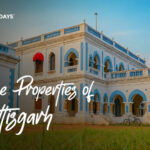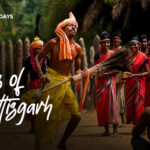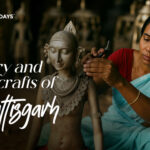- Home
- INDIA
- Offbeat India
- International
- Theme Tours
- Blogs
- Case Studies
- Plan Your Trip
Tripura
Tripura Tour Packages
Tripura
Tripura: One of the Seven Sister Hills of Northeast India
Tripura is a land of tribes, temples, hills, tantalizing cuisine, rich history, and vibrant culture. It’s a state brimming with beauty and adventure, waiting to be explored. This charming region calls out to the traveler in you, offering an array of experiences, from stunning temples and palaces to captivating wildlife sanctuaries and delectable cuisine. If you haven’t already, it’s time to put Tripura on your travel list!
Tripura: A Quick Overview
- Capital: Agartala
- Official Language: English, Bengali, Kokborok
- Dial Code: Agartala – 0381
- Population: 4.07 million (as of 2018)
- Currency: Indian Rupee (INR)
- Time Zone: UTC+05:30 (IST)
- Area: 10,491.69 square km
Highlights of Tripura: Tremendous Tour
Temples
Explore the spiritual side of Tripura by visiting its stunning temples. The Jagannath Temple in Agartala resembles a Disney castle with its pearl-white structure and colorful embellishments. Dedicated to an incarnation of Lord Vishnu, this temple is an important pilgrimage site. The Sundari Temple in Udaipur, one of the 51 Shakti Peeths, stands out with its distinct red and white shrine resembling a delicious cake. To complete your spiritual journey, also visit Bhuvaneswari Temple, Kamalasagar Kali Temple, and Sri Laxminarayan Temple.
Palaces
Floating in the center of Rudrasagar Lake, the red-and-white Neermahal palace is a stunning blend of Hindu and Muslim architectural styles. Originally built as a summer residence for the Tripuri King, this palace is best experienced with a delightful boat ride across the lake. Ujjayanta Palace, located in Agartala, is another architectural marvel that glows like a grand piece of vanilla ice cream. With its terracotta figurines, tribal ornaments, and musical instruments, the palace offers a glimpse into Tripura’s rich heritage. Feel the opulence as you explore these grand palaces, and imagine yourself in the footsteps of kings and queens.
Historical Sites
Travel back in time to Unakoti, an ancient Shiva pilgrimage site dating back to the 7th century. Here, you’ll find rock-cut images and stone carvings depicting one crore Gods and Goddesses who supposedly stopped here on their way to Kashi. The 10-meter tall idol of Shiva and the trio of Ganeshas are bound to leave you awestruck. For a modern yet immersive experience, visit the Tripura State Tribal Museum in Agartala, where interactive exhibits showcase the culture, crafts, and history of the state’s indigenous tribes. From a video wall to enthralling short films, this museum is a gateway to the colorful tribal heritage of Tripura.
Wildlife Sanctuaries
Nature enthusiasts will find Tripura to be an earthly paradise. Sepahijala Wildlife Sanctuary is a must-visit, home to enchanting woodlands, a zoological garden, and the beautiful clouded leopard. The sanctuary also hosts various species like the rhesus macaque, pig-tailed macaque, and spectacled langur. If you’re in the mood for more wilderness exploration, head to Trishna Wildlife Sanctuary, Rowa Wildlife Sanctuary, or Gumti Wildlife Sanctuary.
Cuisine
Tripura’s cuisine is a delightful blend of flavors and textures, promising a gastronomic fiesta. Mui Borok, a dry fermented fish dish cooked with zero oil, is a must-try for its salty, spicy, and tangy notes. Panch Phoron Tarkari, a vegetarian dish made with brinjal, pumpkins, and potatoes, is a flavorful and satisfying choice. For those who love pork, Wahan Mosdeng cooked with onions, coriander leaves, and roasted green chilies, is a plateful of deliciousness you won’t want to miss.
Interesting Facts About Tripura
- NH 44 is the only highway connecting Tripura to the rest of India.
- Neermahal is the only lake palace in Northeast India.
- Children aged 6 to 14 in Tripura have access to free education.
- Tripura Sundari Temple, built in 1501, is one of the 51 Shakti Peeths in India.
- 91% of Tripura’s cultivation is rice.
- The state’s oldest recorded name is Kirat Desh.
Location: Borders and Boundaries
Tripura is bordered by Mizoram in the east and Assam in the northeast. It shares its northern, southern, and western boundaries with Bangladesh, making it one of India’s most culturally diverse states.
Best Time to Visit
Tripura enjoys a relatively cooler climate than mainland India, though it remains humid throughout the year. Summers can go up to 35°C in some parts, while higher altitudes stay cooler. Monsoons bring heavy rain, often resulting in flooding and disrupted connectivity. Hence, winter is the ideal season to visit, with its cool temperatures and low humidity. However, travelers should note that Tripura is in a high-risk zone for cyclones.
How to Get to Tripura: Your Travel Expedition
- By Road: State and private buses connect Agartala to cities like Silchar, Aizawl, Dwarband, Shillong, Imphal, and Guwahati. You can also opt for private vehicles or taxis for a more personalized journey.
- By Rail: The Agartala Railway Station offers connections to key junctions in Guwahati, Siliguri, Jalpaiguri, Sealdah, and New Delhi. Kumarghat Railway Station provides direct trains to cities like Kolkata, Indore, Delhi, Chennai, and Bangalore.
- By Air: Agartala Airport operates direct flights to Kolkata, Bangalore, Guwahati, and Imphal, making it convenient for air travelers.
History: Kings of Kirat Desh
Fossilized wood tools from the valleys of Haora and Khowai trace Tripura’s history back to the Upper Palaeolithic period. Mentioned in the Mahabharata, Puranas, and Edicts of Ashoka, Tripura was ruled for centuries by the Tripuri Kingdom, followed by various Muslim invasions and the Mughal Empire. During British rule, Tripura was a princely state. Post-Independence, it was briefly part of East Pakistan before becoming an Indian state in 1949. It was designated as a Union Territory in 1956 and finally attained statehood in 1963.
Have these intriguing details sparked your interest? Let Ocean6 Holidays guide you through the magnificent landscapes, rich culture, and untold stories of Tripura. Your adventure awaits!
Experiences
- Chanderi SilkNovember 28, 2025
- Waterfalls of ChhattisgarhOctober 29, 2025
- Heritage Properties of ChhattisgarhAugust 12, 2025
- Tribals of ChhattisgarhAugust 12, 2025
- Jewellery and Handicrafts of ChhattisgarhAugust 12, 2025
- Chanderi Silk
Call
98742 84569
98743 61951
Mon-Sat 11.00AM-07.30PMNewsletter
Rate & Review Us
Contact Info
- +91 98742 84569
- experience@ocean6.in
- 16, Suren Tagore Rd, Ekdalia, Ballygunge, Kolkata, West Bengal 700019
- Mon - Sat : 11.00 AM - 7.30 PM
Sunday : CLOSED
Newsletter
Quick Links





